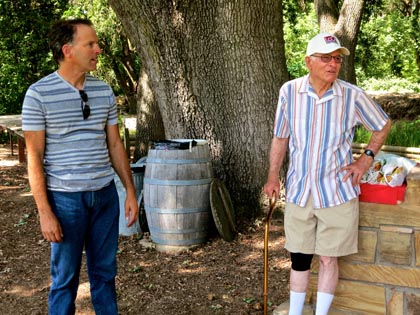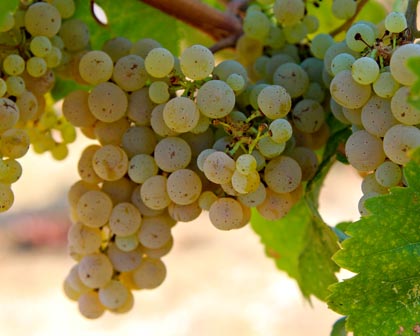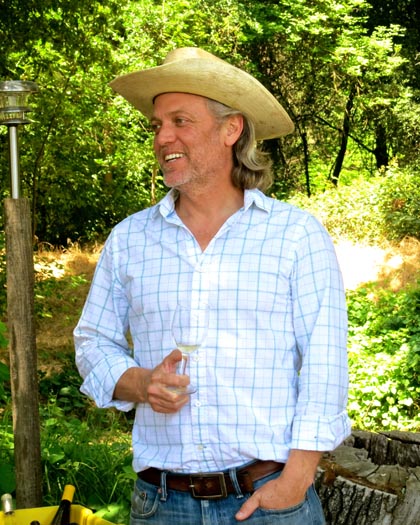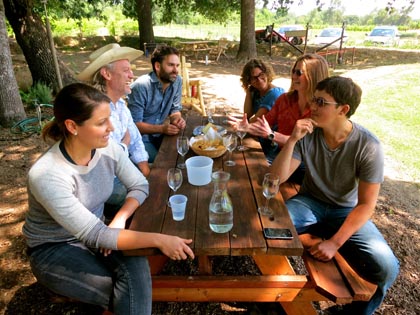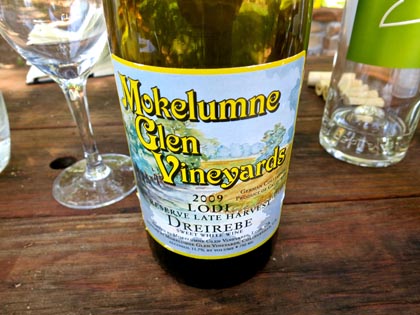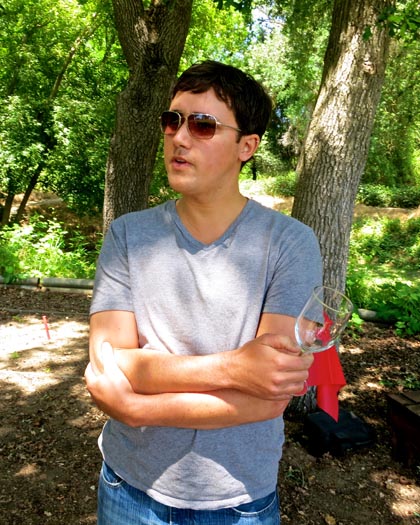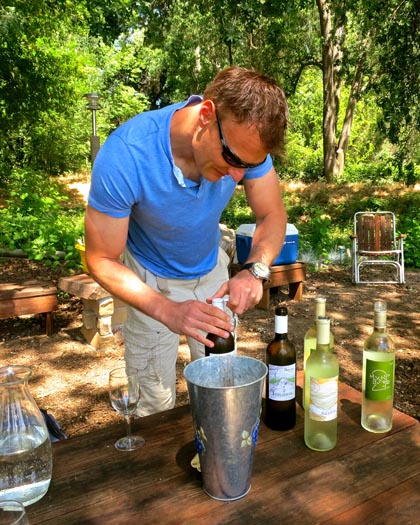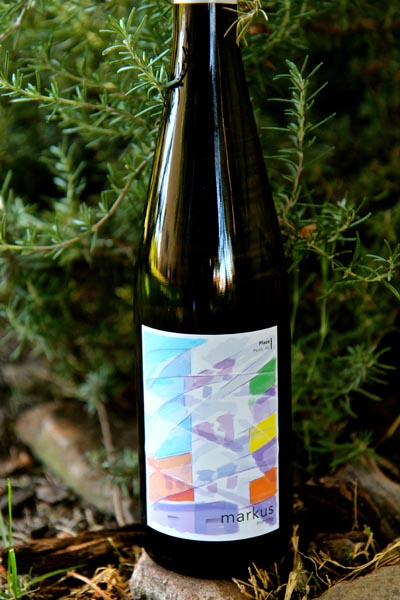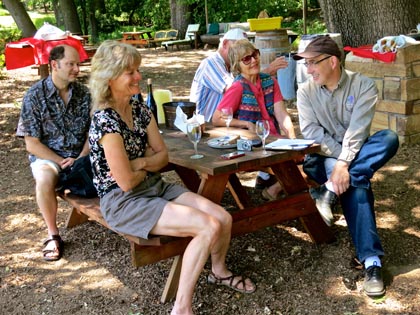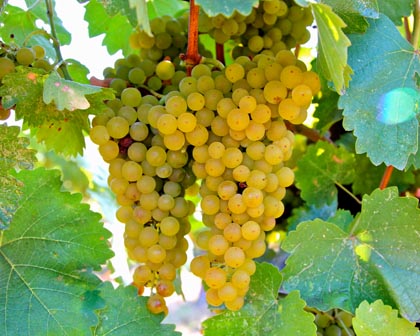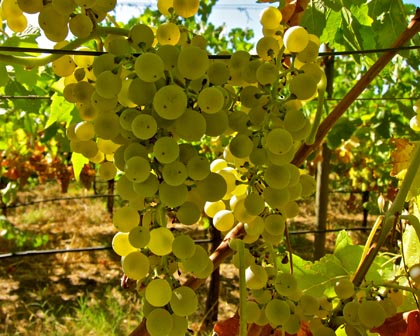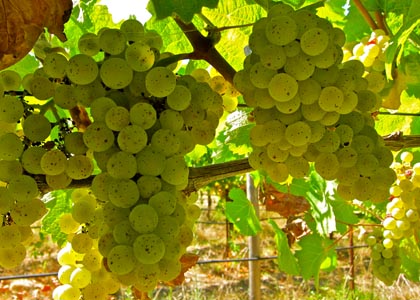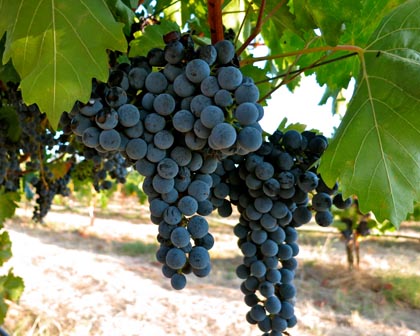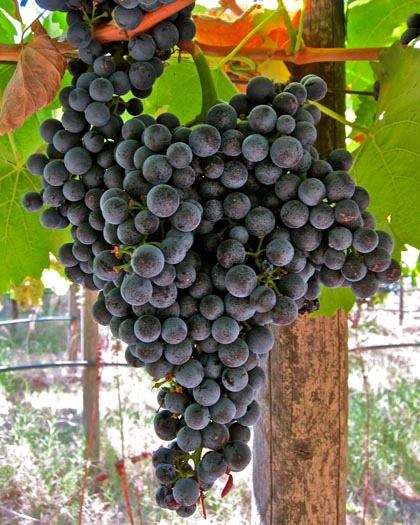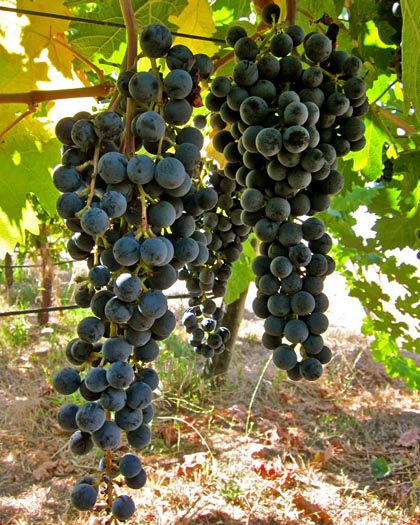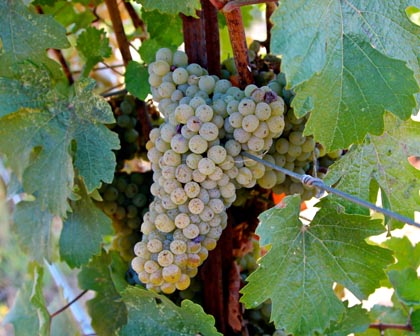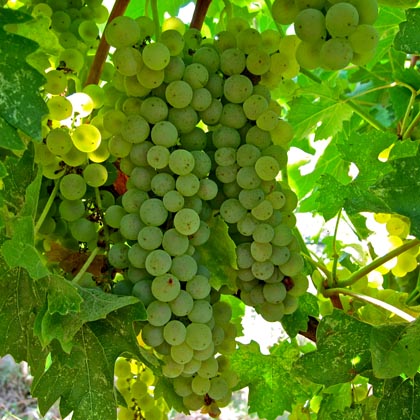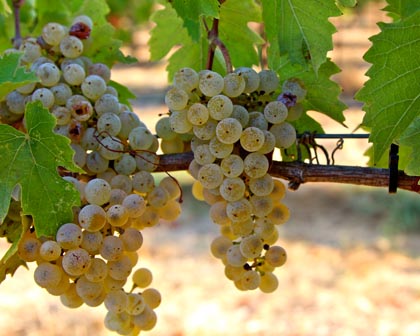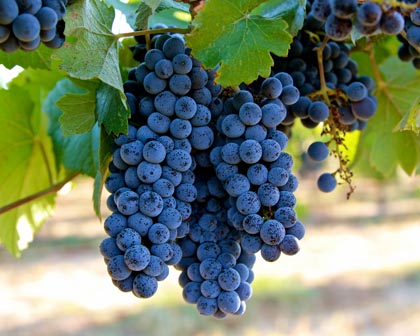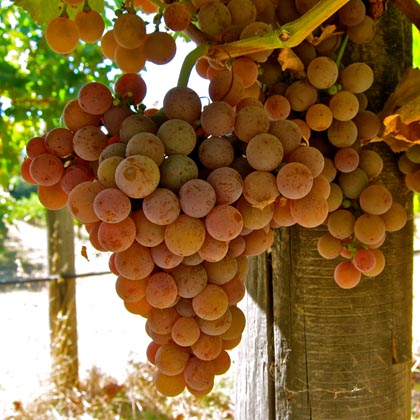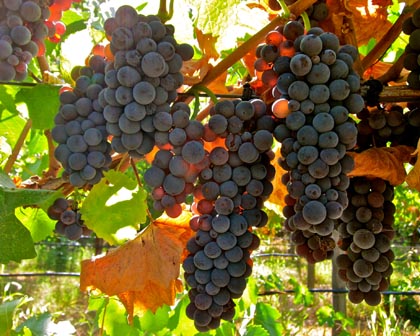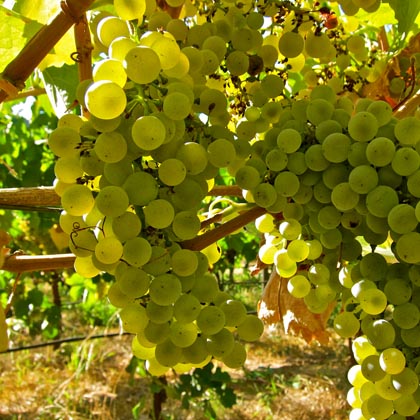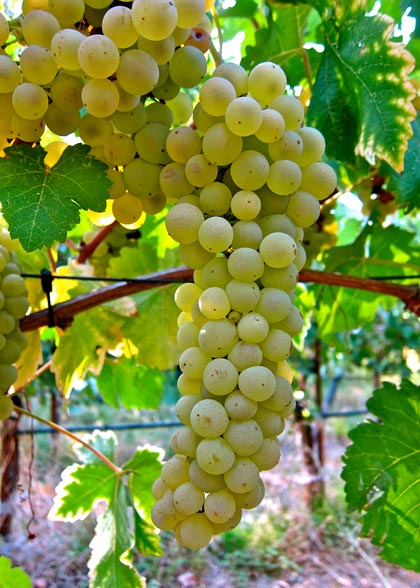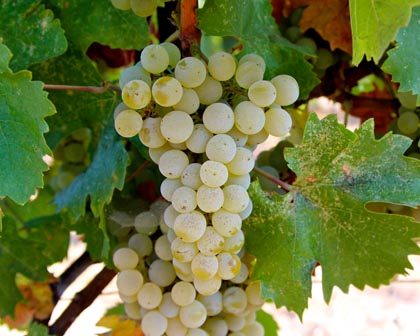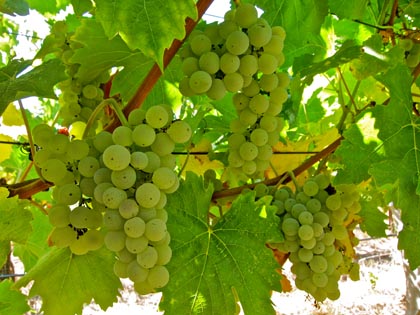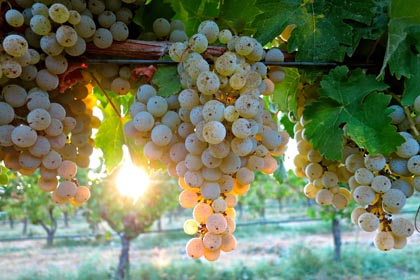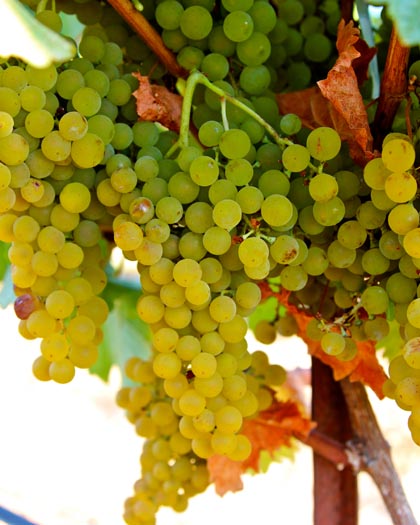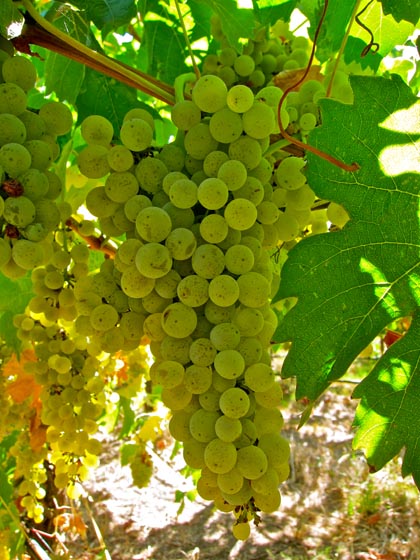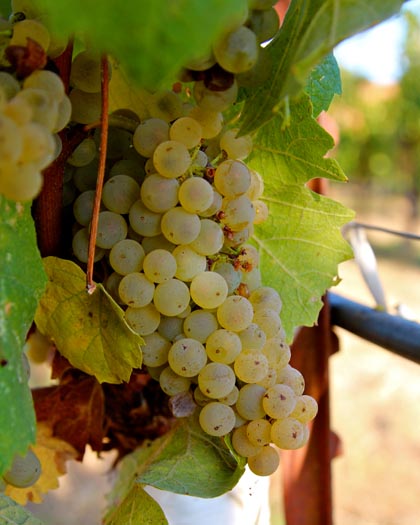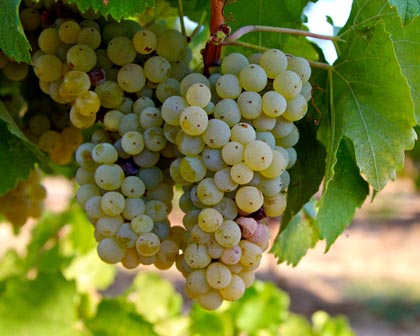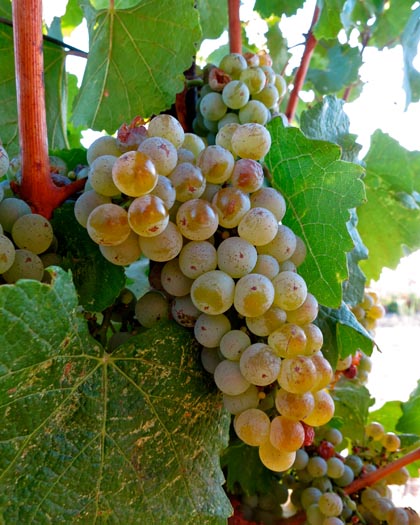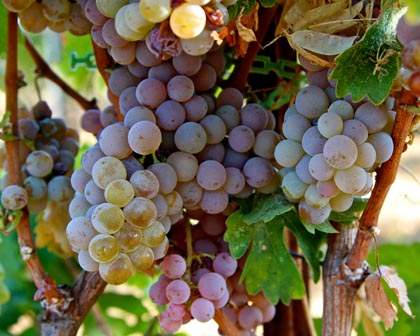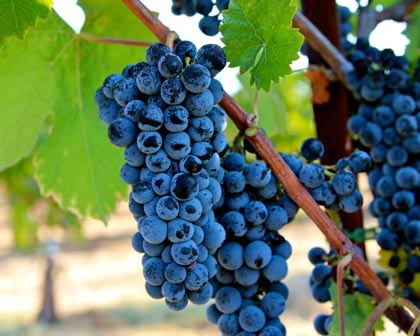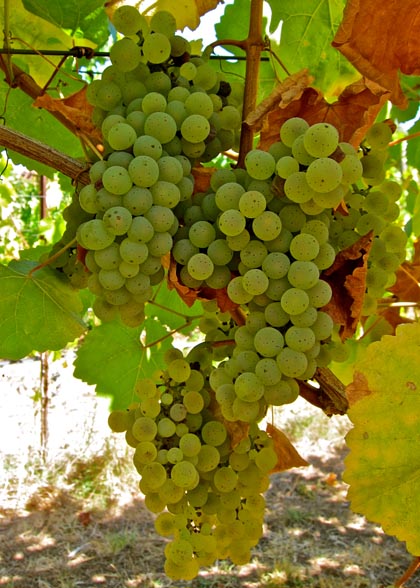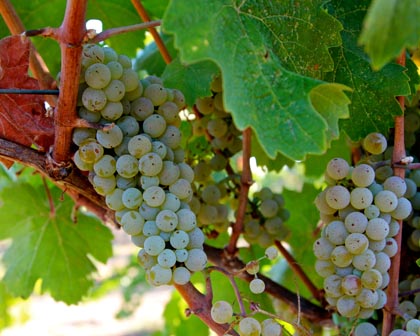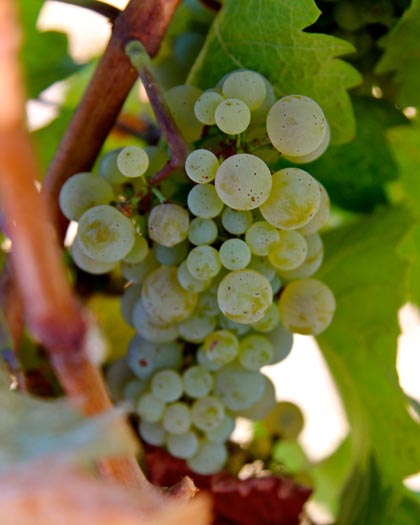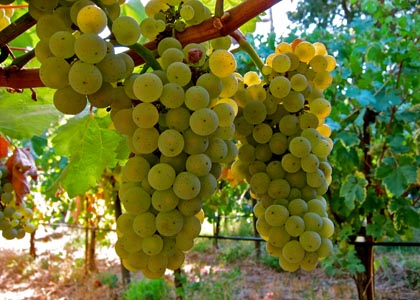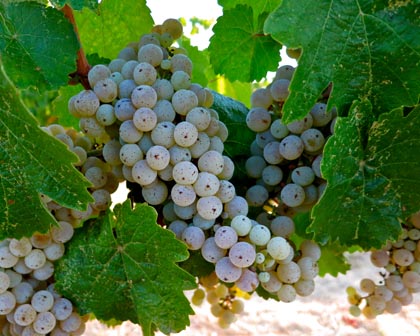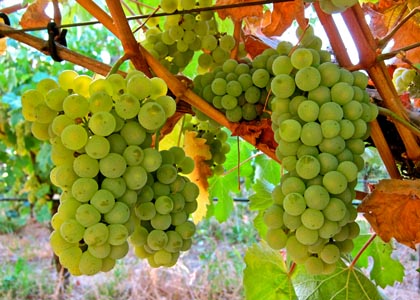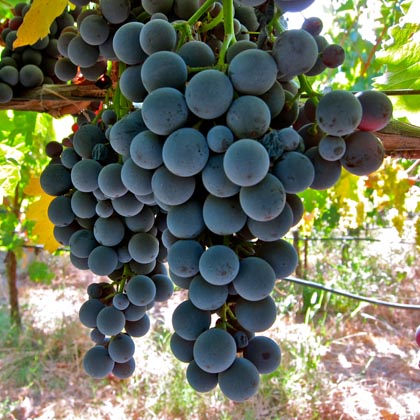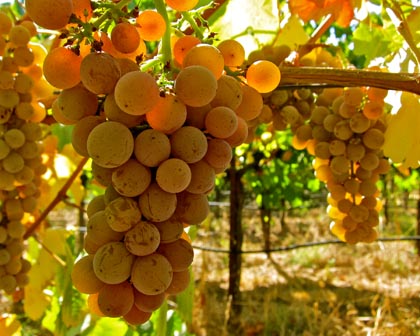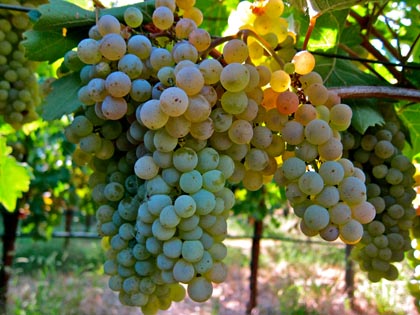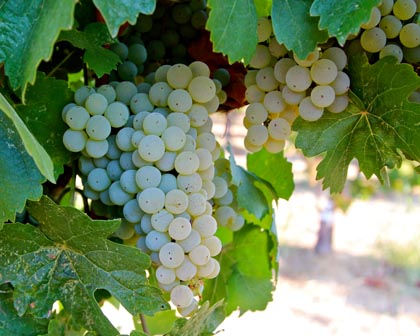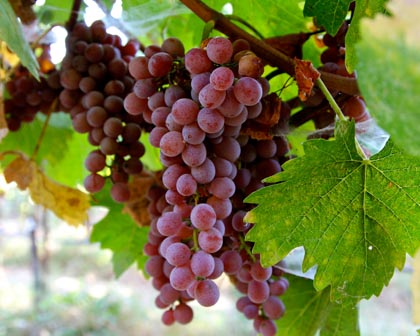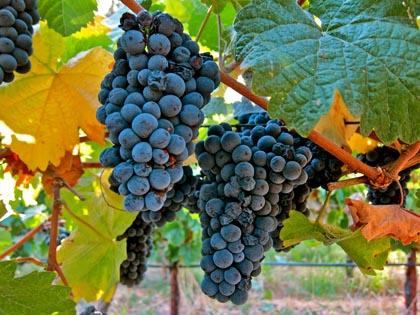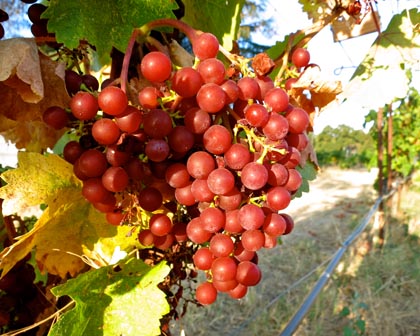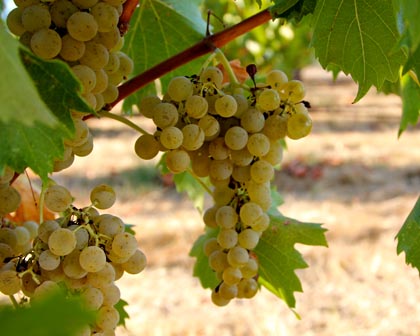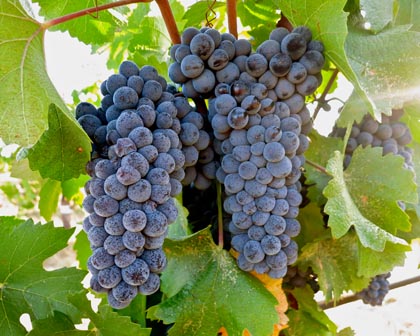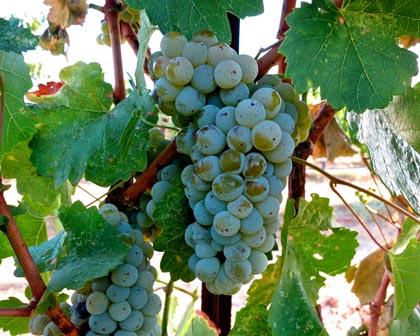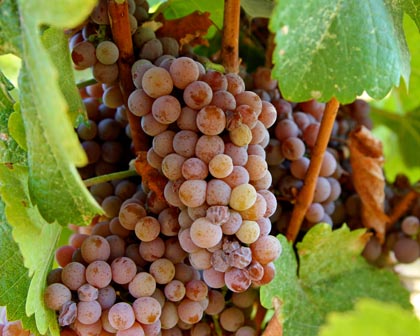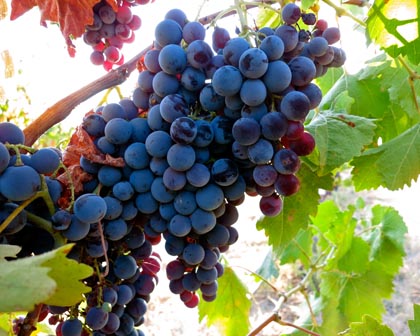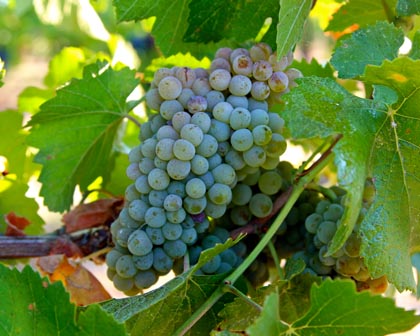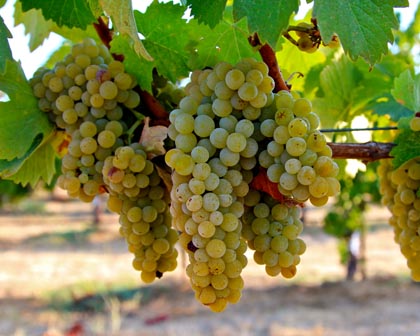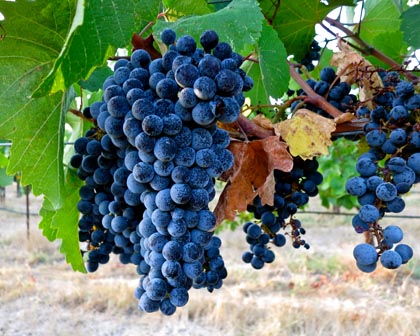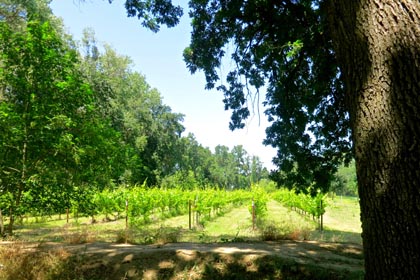Letters from Lodi
An insightful and objective look at viticulture and winemaking from the Lodi
Appellation and the growers and vintners behind these crafts. Told from the
perspective of multi-award winning wine journalist, Randy Caparoso.
Brave new grapes and winemakers discovering Lodi’s Mokelumne Glen
Mokelumne Glen Vineyards’ Brett and Bob Koth at gathering of their winemakers last May
Who'd have thunk? That a planting by a retired Lodi schoolteacher and longtime home winemaker would become the largest, most serious collection (over 40 cultivars!) of German and Austrian grapes in the U.S.
The grape bug took a big bite out of Bob Koth in the early nineties, when he and his wife Mary Lou Koth started traveling back and forth to Germany, where their daughter Ann-Marie was studying on a Fulbright scholarship.
Riesling (Geisenheim clone 198) in Mokelumne Glen
Although Germany is a good, Alpine obstructed distance away from the Mediterranean Sea – and Lodi's dry-summer subtropical climate is classified as Mediterranean (similar in temperature to Napa Valley, Sonoma County, Paso Robles, and other California coastal regions) – Mr. Koth was determined to grow Northern European grapes on his east-side Lodi property, located in a bend of the Mokelumne River that other growers in the neighborhood (such as Lodi's Markus Bokisch and Turley Wine Cellars' Tegan Passalacqua) have recently begun calling "the Peninsula."
While most of Koth's selections amount to just a few vines each, he has expanded his plantings of choice grapes: particularly a couple of Riesling clones, a German crossing called Kerner, and two black skinned grapes known as Dornfelder (a German crossing) and Blaufränkisch (a.k.a. Lemberger); all planted on a slope that gently dips down and cozies up against the banks of the curving Mokelumne River.
(Please see the photographic categorization of Koth’s magnificent grape collection at the end of this blogpost).
No doubt, the immediate proximity to the river's cool, refreshing waters (you still find local kids splashing away on hot summer days) helps to moderate the Mediterranean climate in the Koth family's lush, shaded corner of the wine world.
Furthermore, classic Mokelumne River AVA Tokay sandy loam – basically, a deep, fertile yet porous, slightly alkaline (pH of 7.0 to 7.5 below 4 feet) pile of finely crushed granite accumulated over millions of years of run-off from the Sierra Nevada mountains to the east – helps contribute to retention of natural acidity in grapes cultivated by Koth, even in this Mediterranean setting.
For 11 vintages (1998 through 2009), the Koths – with the help of their son Brett Koth, who manages the vineyard – bottled an eclectic array of wines under their own Mokelumne Glen Vineyards label. Since 2010 they have backed off of commercial wine production, and the grapes have since been going to other wineries, plus a handful of local home winemakers.
In a gathering of some of current grape buyers at the end of this past May (2014) on the property, along the banks of the Mokelumne River, we were given a taste of how the Mokelumne Glen grapes are currently being used. We were also given a peek at the work of a couple of winemakers whose Mokelumne Glen grown wines have yet to be released; pointing out an exciting new direction for the vineyard, as a source of alternative grapes vinified by cutting-edge producers.
Forlorn Hope’s Matthew Rorick in Mokelumne Glen
MATTHEW RORICK, FORLORN HOPE WINES
The big news is that Mokelumne Glen's grape collection have captured the interest of Matthew Rorick, the winemaker/owner of Forlorn Hope Wines, based in California's Suisun Valley AVA. In recent years, Rorick has become a poster boy for a younger crowd of wine geeks, cultivating a taste for alternative style wines made from "unusual" grapes – not what the graying boomers or cougars are accustomed to drinking.
Rorick refers to his wines as "rare creatures" – implying a certain hopelessness in terms of convention or popularity – and he goes further to push that envelope by sticking strictly to minimalist winemaking practices (absolutely no added yeast, enzymes, acid, new oak qualities, etc.), even to the point of producing white wines that look more like rusty nails, sometimes delivering unexpectedly sharp or bitter tactile sensations. Beauty is definitely in the eyes of the beholder when it comes to Forlorn Hope Wines.
In September of 2013 Mr. Rorick made his first foray into Mokelumne Glen; resulting in exactly one barrel (which will amount to about 25 cases worth of wine) co-fermented from a field mix of grapes. Says Rorick, "I can't begin to tell you what we picked – probably mostly Bacchus, a handful of Riesling clones, some Roter Veltliner (a rare Austrian variety), Optima, Sylvaner, Siegerrebe, Scheurebe, and a few more." The Bacchus, described as a late ripener, came in at a moderate 21.5° Brix (i.e. sugar reading); but most of the grapes were picked on the sweeter side, averaging closer to 25° Brix.
Forlorn Hope crew (left side of table) in Mokelumne Glen
Rorick whole cluster pressed and fermented the field mix in neutral oak (that is, a barrel used multiple times to the point where it imparts negligible oak flavor), and the wine was finished completely dry; the alcohol topping out at a good sized 14.6%. Still, this exotic yet-to-be-named Forlorn Hope white was tasting bright and balanced last month; oozing with fragrant tropical fruit qualities, manifested as fairly thick, phenolic, silky sensations on the palate, punctuated by surprisingly pointed natural acidity, and finishing with intertwining mineral inflected notes. This "rare creature" is bound to be loved.
Says Rorick, "Because we learned about the vineyard a little late in the season, we didn't get the grapes in at the lower sugars we would have preferred. But we can't wait until the next harvest (2014) to take another shot. We're still planning on making it an Austrian style field blend… whatever it may be, it will be an interesting!"
On November 19, 2013, as vine leaves had begun to shrivel, Rorick picked a second, "late harvest" of Rieslaner, Weissburgunder (a.k.a. Pinot Blanc), Kerner, and Bacchus grapes at Mokelumne Glen; the sum total weighing in at an average 39.5° Brix. Like the drier field blend, the ultra-sweet grapes were whole cluster pressed and neutral barrel fermented; finishing at 14% alcohol, and a whopping 139 grams of residual sugar per liter: resulting in a golden colored wine with a nose of golden raisins and ripe apricot; lusciously sweet, thick, almost gooey in the texture.
If anything, Forlorn Hope's late picked sweet white wine is a kissing cousin of the Koths' last vintage of their "Dreirebe" – a proprietary blend of Riesling, Weissburgunder and Gewürztraminer. Indeed, also poured alongside the barrel sample of Forlorn Hope’s sweet white blend, the 2009 Mokelumne Glen Lodi Reserve Late Harvest Dreirebe was still tasting incredibly rich and fat with lychee and peach nectar fruitiness – perfect for desserts like fresh berry custard tarts, or sipped as a liquified dessert in itself.
Chad Hinds of the new Sauvage Wines
CHAD HINDS, SAUVAGE WINES
If you have never heard of Sauvage Wines, it's understandable; since the still-to-be-released 2013 Sauvages will be winemaker/owner Chad Hinds' first-ever commercial wines. Mr. Hinds – who is also sourcing grapes from Mendocino and El Dorado – tracked down his Mokelumne Glen grapes through the most modern of ways: through the internet. "I thought, the biggest collection of random grapes ever," recalls Hinds, when reading about Mokelumne Glen.
Hinds tasted us on his 2013 Sauvage Lodi Kerner, sampled from the three neutral barrels in which the wine was fermented on native yeast. Sugar at picking was a moderate 22° Brix, and the wine finished at a fairly soft, round, minerally toned 13.5% alcohol. The slightest touch of residual sugar (about .5%) lends a silky/creamy avocado-like texture, amplifying the fruit-forward, flowery perfume of the grape.
But what really drew Hinds to the Koths' planting was the opportunity to work with their Blaufränkisch – a black skinned grape that has the potential to produce the type of lower alcohol/higher acid/food friendly red wine that Hinds prefers. He tells us: "I picked for pH balance rather than sugar because I wanted to do whole cluster fermentation, to bring out the grape's floral, sweet side. So I picked at lower sugars, closer to 20°, and the wine came out zesty with lots of fruit; and without the alcohol (finishing at just 11.9%) battling the flavors in the mouth."
Borra’s Markus Niggli opening his Mokelumne Glen grown whites
MARKUS NIGGLI, BORRA VINEYARDS
The "outside" winemaker with the most commercial experience working with Mokelumne Glen fruit is actually one of Lodi's better known craftsmen: Markus Niggli of Borra Vineyards.
In a recent story on Lodi's "burgeoning group of small-lot winemakers" called 5 Artisanal Wine Producers, Wine Enthusiast Magazine's Virginie Boone celebrated Niggli's work with Mokelumne Glen fruit; writing, "Niggli has ferreted out obscurities like Kerner and Bacchus planted in Lodi dirt, two white varieties he knew growing up in Switzerland, but hard to find in California… he also sources local Riesling and Gewürztraminer."
The new Markus “Nimmo”
Boone quotes Niggli to say: "The wines are not made up of acids, they are coming from the vineyard that way, so after fermentation, there is no acid added. I aim for freshness and acidity over aromatics. It's something different, and it's something new. Five to six years ago, Lodi was probably not ready for this new wave. As Lodi's changing, more people are paying attention to it. Before, somebody could yell that they had the greatest wine, but nobody was listening."
At the tasting in Mokelumne Glen, Niggli treated us to a comparison of his 2012 and 2013 Borra Lodi "Artist" White: both pure, spring-fresh, lemony dry, light and feathery white wines, fashioned primarily from Kerner and Riesling. He followed up with a taste of the 2013 Borra Lodi "Nuvola" – an airy, bone dry, twist-of-lemon edged and subtly scented 100% Gewürztraminer. All three whites also absolutely destroyed the pervasive myth that Lodi is too "hot" to grow high-acid aromatic grapes: Niggli uses native yeast and employs nothing in the way of acid or any other artificial "adjustments' to his wines, yet the wines show more perky, naturally tart, levitating fruit qualities than most white wines grown anywhere on the West Coast. Go figure.
Perhaps more interesting – particularly for wine lovers who prefer the complexity of oak influence in their white wines – were Niggli's showing of the 2011 and 2012 vintages of the Borra Lodi "Intuition": French and American oak barrel fermented blends of Kerner, Riesling and Gewürztraminer; sneakily crisp, balanced, light-medium bodied, creamy, viscous and delicately floral. What was particularly amazing was how the 2011 has matured in the bottle: already reaching a point where the oak qualities have faded into the backdrop, like a thin, delicate frame that simply underscores the wine's intrinsic aromatic mult-fruit character, allowing the acidity and moderate alcohol (12.8%) to pull crisp and creamy sensations seamlessly together.
Followers of Mr. Niggli's work at Borra Vineyards will be interested to know that, starting with the 2013 vintage, the Mokelumne Glen sourced wines will start to come out under the Markus label, to distinguish them from wines estate grown in Borra's own vineyards in the Mokelumne River and Clements Hills AVAs.
The breaking news? Just bottled, late last month (June): the 2013 Markus Lodi "Nimmo" is beautifully packaged in a coolly colored impressionistic label designed by Lodi artist Michael Leonard; and is a completely dry, barrel fermented blend of Kerner (69%), Gewürztraminer, Riesling and Bacchus, already popping from the bottle with subtle yet effusive citrus perfumes, teasing the palate with sensations of candied tangerine, neatly wrapped in pert, perky, tautly tart and transparent, viscous textures.
Niggli himself describes his barrel influenced Nimmo as more of a "restaurant wine." According to Niggli: "It is a serious, complex wine meant for complex foods, like dishes prepared by chefs with creamy or buttery sauces. At the same time, the label's colors are designed to stand out on a retail shelf. As complex as it is, Nimmo is also a clean, contemporary style wine deliberately crafted in a feminine style, for a feminine appeal. I can see this wine being very attractive to the 22 to 25-year old female"… or, we imagine, a young male with equally sympathetic tastes.”
From left: Todd Hafner (home winemaker who has used Mokelumne Glen grapes for 10 years); Ann-Marie Koth; Bob & Mary Lou Koth; Jon Bjork (the “Lodi Wine Guy”)
Above all, says Niggli, wines made from grapes grown in Mokelumne Glen "show what interesting things can be done in Lodi, despite prevailing opnions. Lodi has a lot to offer to many of today's consumers, especially the ones with different tastes. These grapes give us the opportunity to be a leader, not a follower, in this area, and I'm looking forward to being more of a part of this over the next few years!"
THE MOKELUMNE GLEN ESTATE WINE GRAPES
The following is a photographic accounting of the stunning array of grapes grown in this Lodi AVA estate, one of the most unusual vineyards in the entire U.S.; with notations for cultivars that are propagated crossings of Vitis vinifera grapes, or else hybrids (crosses of different species within the Vitis genus):
Albolonga (Rieslaner x Silvaner)
Arnsburger (Riesling clones 88 x 64)
Bacchus: (Silvaner x Riesling) x Muller-Thurgau
Blauer Portugieser
Blaufrankisch (a.k.a. Lemberger)
Dornfelder: Helfensteiner (Fruhburgunder x Trollinger) x Heroldrebe (Blauer Portugieser x Blaufrankisch)
Ehrenfelser (Riesling x Silvaner)
Faberrebe (a.k.a. Faber): Pinot Blanc x Muller-Thurgau
Forta (Silvaner x Madeleine Angevine)
Freuburgunder (a.k.a. Pinot Noir Precoce)
Gewürztraminer
Grauburguner (a.k.a. Pinot Gris; Rulander)
Gruner Veltliner
Gutedel (a.k.a. Chasselas)
Huxelrebe (Gutedel x Courtiller Musque)
Kanzler (Muller-Thurgau x Silvaner)
Kerner (Trollinger x Riesling)
Morio Muscat (Silvaner x Weissburgunder)
Muller-Thurgau (Riesling x Silvaner)
Noblessa (Madeleine Angevine x Silvaner)
Optima: (Riesling x Silvaner) x Muller-Thurgau
Oraniensteiner (Riesling x Silvaner)
Perle (Gewurztraminer x Muller-Thurgau)
Regent – hybrid variety: Diana (Silvaner x Muller-Thurgau) x Chambourcin
Rieslaner (Silvaner x Riesling)
Riesling; Alsatian clone 49
Riesling; Geisenheim clone 110
Riesling; Geisenheim clone 198
Riesling; Geisenheim clone 239
Riesling; Neudstadt clone 90
Rotberger (Trollinger x Riesling)
Roter Traminer (a.k.a. Savagnin Rose)
Roter Veltliner
Scheurebe (Riesling x unknown wild vine)
Schonburger: Pinot Noir x (Chasselas x Muscat Hamburg)
Schwarzriesling (a.k.a. Pinot Meunier)
Siegerrebe (Madeleine Angevine x Gewurztraminer)
Sirius – hybrid variety: Bacchus x Villard Blanc
St. Laurent
Silvaner (a.k.a. Sylvaner)
Traminer (a.k.a. Savagnin)
Trollinger
Weissburgunder (a.k.a. Pinot Blanc)
Wurzer (Gewurztraminer x Muller-Thurgau)
Zweigelt (St. Laurent x Blaufrankisch)
Mokelumne Glen Riesling block along the banks of Mokelumne River
